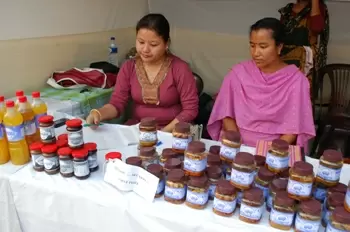Protecting people’s interest even while saving endangered species and forests
17-February-2012
Vol 3 | Issue 7
Mrinali Moshahary had never imagined that her bottles of papaya jelly would be an instant hit among those visiting the North East Agri-Fair 2012 in the Khanapara area of Guwahati.
It was a dream come true for Mrinali from a village bordering Manas National Park, located on the India-Bhutan border in eastern Assam, to sell some of her produces in Assam's main city, Guwahati.
 |
|
Aaranyak has provided alternative livelihood skills to people living in the fringe areas of Manas National Park
|
Aaranyak, a leading bio-diversity group in Assam, started a novel project about two and a half years ago to provide means of alternative livelihood to the people in the fringe areas of Manas National Park who have been dependent on the jungle for their daily necessities.
"The plan was to provide the people of the fringe areas with alternative livelihood so that their dependency on the jungle and forest reduces, leading to successful conservation of biodiversity, and also to encourage community participation in the conservation of Manas National Park through self-reliant economic activities in fringe villages," says Bibhuti Prasad Lahkar, secretary of Aaranyak.
Located in the Himalayan foothills, Manas National Park is a Project Tiger Reserve and a Biosphere Reserve in Assam. It is about 180 km away from Assam's main city Guwahati and is contiguous with the Royal Manas National park in Bhutan.
The park is known for its rare and endangered endemic wildlife, such as the Assam Roofed Turtle, Hispid Hare, Golden Langur and Pygmy Hog. It is also famous for its population of the Wild water buffalo.
"We help forming some Self Help Groups (SHG) by gathering the men and women of the area and train them in food processing and weaving," said Lahkar, adding that Aaranyak also helped in marketing their products through various trade fairs and agri-horticulture fairs across the state.
Along with Mrinali, there are 22 Bodo women in Madangshri, a self-help group. They earn a good amount of money per month through SHGs. "Now as the dependency on forest has reduced, these SHGs also help us with conservation activities in the forest," Lahkar said.
"Hunting, which was common among Bodo and Adivasi communities living in the fringe areas of the Manas National Park, has been reduced," said Namita Brahma, a researcher with Aaranyak.
"Although we have a small piece of land for farming we were mainly dependent on the forest. We cannot grow paddy as the crops often get destroyed by stray elephants and rhinos. First, I enrolled myself for the training of food processing and learned to make juice, jam and jelly. Later, I enrolled my sister too, so that both of us can supplement the family income," said Mrinali.
"We had brought about 40 bottles of our produce. All got sold out on the second day of the fair," said Krishna Basumatary, a member of the SHG, who has for the first time ventured out from her village to Guwahati.
Soneswari Mushahary, one of the members of Madangshri, said: "The success story of our SHG has inspired many other Bodo women to start similar ventures. We are happy to become a part of the conservation of Manas."
The successful conservation activity of the Manas National Park has led the Aaranyak to expand similar self-reliance activity in fringe villages of the Kaziranga national park.
"The participation of villagers of fringe villages in any national park is a must for successful conservation activity. We have started similar projects in some villages near the Kaziranga national park this year," said researcher Namita. - IANS














